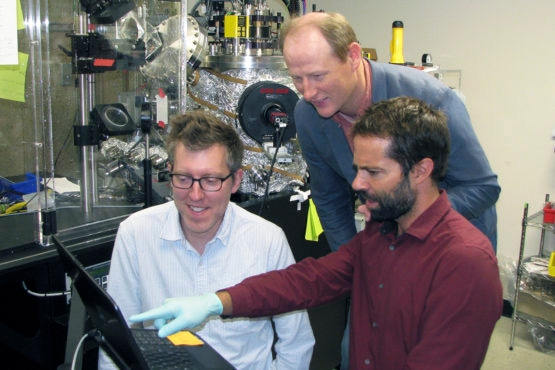CO2 Could Power Planes, Trains, and Ships Someday
An improved method for converting carbon dioxide to carbon monoxide could create a viable alternative energy source for modes of heavy transport.
October 8, 2019

|
From left: Researchers Christopher Graves, Michal Bajdich and Michael Machala work on the development of a new method for converting carbon dioxide into carbon monoxide for carbon-neutral fuels. (Image source: Mark Golden) |
While researchers have experimented with using alternative fuels for large modes of transport such as airplanes, so far they haven’t found a truly viable option.
That could change thanks to new research from scientists at Stanford University and the Technical University of Denmark (DTU), who have developed a new method for turning carbon dioxide into energy-rich carbon monoxide.
This crucial conversion is the first step to transforming carbon monoxide into nearly any liquid “carbon-neutral” fuel and even synthetic gas and plastics. The researchers believe their method could lead to cost-effective ways to more broadly convert larger quantities of carbon dioxide into carbon monoxide for the production of carbon-neutral fuels. Lowering costs and other barriers could lead to viable fuels for even heavy modes of transportation, which require energy-dense fuels.
The latest breakthrough was led by William Chueh, an associate professor of materials science and engineering at Stanford, and Christopher Graves, associate professor in DTU’s Energy Conversion & Storage Department. Theis Skafte, a DTU doctoral candidate at the time, also participated in the work, which took place at Stanford. The team published a recent study on their work in the journal Nature Energy.
Chueh and Graves had been separately working on high-temperature electrolysis of carbon dioxide for years, but the breakthrough came only when the teams put their heads together, said Skafte, now a postdoctoral researcher at DTU.
“We achieved something we couldn’t have separately – both a fundamental understanding and practical demonstration of a more robust material,” he said in a press statement.
RELATED ARTICLES:
Removing Key Barriers
The Stanford/DTU research team used electricity and an Earth-abundant catalyst, cerium oxide (also known as ceria), to convert carbon dioxide into carbon monoxide. Unlike other catalysts used in this process, cerium oxide is much more resistant to breaking down.
Plants transform carbon dioxide to carbon-rich sugars naturally, but scientists still have yet to find a commercially viable artificial electrochemical route to turn this gas into carbon monoxide. Current devices developed to do this use too much electricity, convert a low percentage of carbon dioxide molecules, or produce pure carbon that destroys the device, according to the researchers.
For their approach, the Stanford-DTU team built two cells for carbon dioxide conversion testing – one with cerium oxide and the other with conventional nickel-based catalysts. What they found is that the ceria electrode remained stable, while carbon deposits damaged the nickel electrode, which substantially shortened the catalyst’s lifetime.
“This remarkable capability of ceria has major implications for the practical lifetime of CO2 electrolyzer devices,” Graves said in a press statement. “Replacing the current nickel electrode with our new ceria electrode in the next-generation electrolyzer would improve device lifetime.”
Elizabeth Montalbano is a freelance writer who has written about technology and culture for more than 20 years. She has lived and worked as a professional journalist in Phoenix, San Francisco and New York City. In her free time she enjoys surfing, traveling, music, yoga and cooking. She currently resides in a village on the southwest coast of Portugal.
The Midwest's largest advanced design and manufacturing event! |
About the Author(s)
You May Also Like





